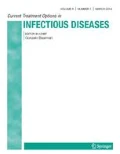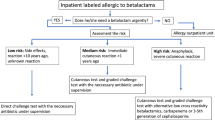Abstract
Purpose of review
Beta-lactam allergies, and specifically penicillin allergies, result in receipt of therapy that is not considered first line in many instances. Being labeled as allergic many times comes via subjective history from the patient. Carrying this label can cause a patient to receive broad-spectrum therapy with increased side effects and resistance. Antimicrobial stewardship programs can play a role in allergy evaluation and intervention based on resources. This review provides an update on beta-lactam allergies and emphasizes incorporation of evaluating these patients as a core tenant of antimicrobial stewardship.
Recent findings
Many patients with a listed beta-lactam allergy are not truly allergic and can have the allergy removed with proper evaluation. Patients who have low-risk histories that are unlikely to be IgE mediated can safely be re-challenged. High-risk patients or those with an unknown history can be desensitized or skin tested (if allergic to penicillin). All strategies should result in proper labeling or de-labeling in the electronic health record. Antimicrobial stewardship programs are recommended to be involved in allergy assessments to create testing and treatment strategies.
Summary
Deciding whether an allergic patient is a candidate for re-challenge or graded-challenge, penicillin skin testing, or desensitization is paramount to antimicrobial stewardship programs in conjunction with an allergist, if available.

Similar content being viewed by others
References and Recommended Reading
Papers of particular interest, published recently, have been highlighted as: • Of importance •• Of major importance
Solensky R, Khan DA, Bernstein IL, Oppenheimer J, Tilles S, Dowling PJ, et al. Drug allergy: an updated practice parameter. Ann Allergy Asthma Immunol. 2010;105:259–73.
• Bland CM, Bookstaver PB, Griffith NC, Heil EL, Jones BM, Justo JA, et al. A practical guide for pharmacists to successfully implement penicillin allergy skin testing. Am J Health Syst Pharm. 2019;76(3):136–47 This article offers practical guidance on multiple ways to implement penicillin skin testing in the healthcare setting depending on resources available.
King EA, Challa S, Curtin P, Bielory L. Penicillin skin testing in hospitalized patients with β-lactam allergies: effect on antibiotic selection and cost. Ann Allergy Asthma Immunol. 2016;117:67–71.
Unger NR, Gauthier TP, Cheung LW. Penicillin skin testing: potential implications for antimicrobial stewardship. Pharmacotherapy. 2013;33:867.
•• Shenoy ES, Macy E, Rowe T, Blumenthal KG. Evaluation and management of penicillin allergy: a review. JAMA. 2019;321(2):188–99 This study provides risk stratification for patients with a listed penicillin allergy and how to approach evaluation and treatment.
Albin S, Agarwal S. Prevalence and characteristics of reported penicillin allergy in an urban outpatient adult population. Allergy Asthma Proc. 2014;35:489–94.
Picard M, Begin P, Bouchard H, Cloutier J, Lacombe-Barrios J, Paradis J, et al. Treatment of patients with a history of penicillin allergy in a large tertiary-care academic hospital. J Allergy Clin Immunol Pract. 2013;1:252–7.
Gell PGH, Coombs RA. The classification of allergic reactions underlying disease. Oxford: Blackwell; 1963.
Riedl MA, Casillas AM. Adverse drug reactions: types and treatment options. Am Fam Physician. 2003;68(9):1781–91.
Sogn DD, Evans R, Shepherd GM, Casale TB, Condemi J, Greenberger PA. Results of the National Institute of Allergy and Infectious Diseases collaborative clinical trial to test the predictive value of skin testing with major and minor penicillin derivatives in hospitalized adults. Ann Intern Med. 1992;152:1025–32 IIa.
Blanca M, Torres MJ, Garcia JJ, et al. Natural evolution of skin test sensitivity in patients allergic to beta-lactam antibiotics. J Allergy Clin Immunol. 1999;103:918–24 III.
Hoetzenecker W, Nageli M, Mehra ET, Jensen AN, Saulite I, Schmid-Grendelmeier P, et al. Adverse cutaneous drug eruptions: current understanding. Semin Immunopathol. 2016;38(1):75–86.
Sivagnanam S, Deleu D. Red man syndrome. Crit Care. 2003;7(2):119–20.
Campbell RL, Li JTC, Nicklas RA, Sadosty AT, Members of the Joint Task Force. Practice Parameter/Workgroup. Emergency department diagnosis and treatment of anaphylaxis: a practice parameter. Ann Allergy Asthma Immunol. 2014;113(6):599–608.
Executive summary of disease management of drug hypersensitivity: a practice parameter. Joint Task Force on Practice Parameters, the American Academy of Allergy, Asthma and Immunology, and the Joint Council of Allergy, Asthma and Immunology. Ann Allergy Asthma Immunol. 1999;83:665–700.
Joint Commission on Hospital Accreditation. Approved: new antimicrobial stewardship standard. Jt Comm Perspect. 2016;36(7):1–8.
Barlam TF, Cosgrove SE, Abbo LM, MacDougall C, Schuetz AN, Septimus EJ, et al. Implementing an antibiotic stewardship program: guidelines by the Infectious Diseases Society of America and the Society for Healthcare Epidemiology of America. Clin Infect Dis. 2016;62(10):e51–77.
Trubiano JA, Beekmann SE, Worth LJ, et al. Improving antimicrobial stewardship by antibiotic allergy delabeling: evaluation of knowledge, attitude, and practices throughout the emerging infections network. Open Forum Infect Dis. 2016;(3):ofw153 eCollection 2016 Sep.
• Trubiano JA, Thursky KA, Stewardson AJ, Urbancic K, Worth LJ, Jackson C, et al. Impact of an integrated antibiotic allergy testing program on antimicrobial stewardship: a multicenter evaluation. Clin Infect Dis. 2017;65(1):166–74 This study describes an integrated program focused on de-labeling antibiotic allergies, while promoting improving antibiotic usage from incorporation into antimicrobial stewardship.
Ramsey A, Staicu ML. Use of a penicillin allergy screening algorithm and penicillin skin testing for transitioning hospitalized patients to first-line antibiotic therapy. J Allergy Clin Immunol Pract. 2018;6(4):1349–55.
Jones BM, Bland CM. Penicillin skin testing as an antimicrobial stewardship initiative. Am J Health Syst Pharm. 2017;74(4):232–7.
Gugkaeva Z, Crago JS, Yasnogorodsky M. Next step in antibiotic stewardship: pharmacist-provided penicillin allergy testing. J Clin Pharm Ther. 2017;42(4):509–12.
Staicu ML, Brundige ML, Ramsey A, Brown J, Yamshchikov A, Peterson DR, et al. Implementation of a penicillin allergy screening tool to optimize aztreonam use. Am J Health Syst Pharm. 2016;73(5):298–306.
Chen JR, Tarver SA, Alvarez KS, Wei W, Khan DA. Improving aztreonam stewardship and cost through a penicillin allergy testing clinical guideline. Open Forum Infect Dis. 2018;5(6):ofy106.
Caplinger C, Smith G, Remington R, Madaras-Kelly K. Evaluation of a computerized decision support intervention to decrease use of anti-pseudomonal carbapenems in penicillin allergic patients. Antibiotics (Basel). 2016;5(1):E7.
Staicu ML, Holly AM, Conn KM, Ramsey A. The use of telemedicine for penicillin allergy skin testing. J Allergy Clin Immunol Pract. 2018;6(6):2033–40.
McDanel JS, Perencevich EN, Diekema DJ, Herwaldt LA, Smith TC, Chrischilles EA, et al. Comparative effectiveness of beta-lactams versus vancomycin for treatment of methicillin-susceptible Staphylococcus aureus bloodstream infections among 122 hospitals. Clin Infect Dis. 2015;61(3):361–7.
Phan A, Allen B, Epps K, Alikhil M, Kamataris K, Tucker C. Initiative to reduce aztreonam use in patients with self-reported penicillin allergy: Effects on clinical outcomes and antibiotic prescribing patterns. Am J Health Syst Pharm. 2018;75(17 Supplement 3):S58–62.
Chiriac AM, Banerji A, Gruchalla RS, Thong BYH, Wickner P, Mertes PM, et al. Controversies in drug allergy: drug allergy pathways. J Allergy Clin Immunol Pract. 2019;7(1):46–60.e4.
Torda A, Chan V. Antibiotic allergy labels-the impact of taking a clinical history. Int J Clin Pract. 2018;72:e13058.
Romano A, Valluzzi RL, Caruso C, Maggioletti M, Quaratino D, Gaeta F. Cross-reactivity and tolerability of cephalosporins in patients with IgE-mediated hypersensitivity to penicillins. J Allergy Clin Immunol Pract. 2018;6(5):1662–72.
Romano A, Viola M, Guéant-Rodriguez RM, Gaeta F, Valluzzi R, Guéant JL. Brief communication: tolerability of meropenem in patients with IgE-mediated hypersensitivity to penicillins. Ann Intern Med. 2007;146(4):266–9.
Romano A, Viola M, Guéant-Rodriguez RM, Gaeta F, Pettinato R, Guéant JL. Imipenem in patients with immediate hypersensitivity to penicillins. N Engl J Med. 2006;354(26):2835–7.
Baddour LM, Wilson WR, Bayer AS, Folwer VG, Tleyjeh IM, Rybak MJ, et al. Infective endocarditis in adults: diagnosis, antimicrobial therapy, and management of complications: a scientific statement for healthcare professionals from the American Heart Association. Circulation. 2015;132(15):1435–86.
Workowski KA, Bolan GA, Centers for Disease Control and Prevention. Sexually Transmitted Diseases Treatment Guidelines, 2015. MMWR Recomm Rep. 2015;64(RR-03):1–137.
Tunkel AR, Hasbun R, Bhimraj A, Byers K, Kaplan SL, Scheld WM, et al. 2017 Infectious Diseases Society of America’s Clinical Practice Guidelines for Healthcare-Associated Ventriculitis and Meningitis. Clin Infect Dis. 2017;64(6):701–6.
Kalil AC, Metersky ML, Klompas K, Muscedere J, Sweeney DA, Palmer LB, et al. Management of adults with hospital-acquired and ventilator-associated pneumonia: 2016 clinical practice guidelines by the Infectious Diseases Society of America and the American Thoracic Society. Clin Infect Dis. 2016;63(5):e61–e111.
Mattingly TJ, Fulton A, Lumish RA, Williams AMC, Yoon S, Yuen M, et al. The cost of self-reported penicillin allergy: a systematic review. J Allergy Clin Immunol Pract. 2018;6:1649–54.
Van Dijk SM, Gardarsdottir H, Wassenbery MWM, Oosterheert JJ, de Groot MCH, Rockmann H, et al. The High Impact of Penicillin Allergy Registration in Hospitalized Patients. J Allergy Clin Immunol Pract. 2016;4:926–31.
Sousa-Pinto B, Cardoso-Fernandes Á, Araújo L, Fonseca JA, Freitas A, Delgado L. Clinical and economic burden of hospitalizations with registration of penicillin allergy. Ann Allergy Asthma Immunol. 2018;120:190–4.
Macy E, Vyles D. Who needs penicillin allergy testing? Ann Allergy Asthma Immunol. 2018;121:523–9.
Trubiano JA, Smibert O, Douglas A, Devhand M, Lambros B, Holmes NE, et al. The safety and efficacy of an oral penicillin challenge program in cancer patients: a multicenter pilot study. Open Forum Infect Dis. 2018;5(12):1–5.
Iammatteo M, Alvarez Arangeo S, Ferastraoaru D, Akbar N, Lee AY, Cohen HW, et al. Safety and outcomes of oral graded challenges to amoxicillin without prior skin testing. J Allergy Clin Immunol Pract. 2019;7(1):236–43.
Legendre DP, Muzny CA, Marshall GD, Swialto E. Antibiotic hypersensitivity reactions and approaches to desensitization. Clin Infect Dis. 2014;58(8):1140–8.
Sacco KA, Cochran BP, Epps K, Parkulo M, Gonzalez-Estrada A. Inpatient B-lactam test-dose protocol and antimicrobial stewardship in patients with a history of penicillin allergy. Ann Allergy Asthma Immunol. 2019;122:184–8.
Sacco KA, Bates A, Brigham TJ, Inam JS, Burton MC. Clinical outcomes following inpatient penicillin allergy testing: a systematic review and meta-analysis. Allergy. 2017;72(9):1288–96.
Confino-Cohen R, Rosman Y, Meir-Shafrir K, Stauber T, Lachover-Roth I, Hershko A, et al. Oral challenge without skin testing safely excludes clinically significant delayed-onset penicillin hypersensitivity. J Allergy Clin Immunol Pract. 2017;5:669–75.
Jones B, Crosby J, Bland C. Use of penicillin skin testing as an antimicrobial stewardship initiative: clinical and economic evaluation at a community health system. Open Forum Infect Dis. 2017;4(Suppl 1):S491–2.
Estep PM, Fierreira JA, Dupree LH, Aldridge PJ, Jankowski CA. Am J Health Syst Pharm. 2016;73(5 Suppl 1):S8–13.
Centers for Disease Control and Prevention. 2015 Sexually Transmitted Diseases Treatment Guidelines: Syphilis. https://www.cdc.gov/std/tg2015/syphilis.htm. Reviewed 2015.
Wendell GD, Stark BJ, Jamison RB, Molina RD, Sullivan TJ. Penicillin allergy and desensitization in serious infections during pregnancy. N Engl J Med. 1985;312:1229–32.
Magpantay G, Cardile AP, Madar CS, Hsue G, Belnap C. Antibiotic desensitization therapy in secondary syphilis and Listeria infection: case reports and review on desensitization therapy. Hawaii Med J. 2011;70(12):266–8.
Warrington RJ, Lee KR, McPhillips S. The value of skin testing for penicillin allergy in an inpatient population: analysis of the subsequent patient management. Allergy Asthma Proc. 2000;21:297–9.
Rimawi RH, Shah KB, Cook PP. Risk of redocumenting penicillin allergy in a cohort of patients with negative penicillin skin tests. J Hosp Med. 2013;8(11):615–8.
Blumenthal KG, Shenoy ES, Hurwitz S, Varughese CA, Hooper DC, Banerji A. Effect of a drug allergy educational program and antibiotic prescribing guideline on inpatient clinical providers’ antibiotic prescribing knowledge. J Allergy Clin Immunol Pract. 2014;2(4):407–13.
Author information
Authors and Affiliations
Corresponding author
Ethics declarations
Conflict of interest
B.J. and C.B. have received research funding from ALK-Abello and have both served as consultants for ALK-Abello. C.M. declares she has no conflict of interest S.M. declares that she has no conflict of interest. E.W. declares that she has no conflict of interest. C.J. declares that she has no conflict of interest.
Human and animal rights and informed consent
This article does not contain any studies with human or animal subjects performed by any of the authors.
Additional information
Publisher’s Note
Springer Nature remains neutral with regard to jurisdictional claims in published maps and institutional affiliations.
This article is part of the Topical Collection on Antimicrobial Stewardship
Rights and permissions
About this article
Cite this article
Jones, B.M., Jozefczyk, C., Maguire, C. et al. Beta-lactam Allergy Review: Implications for Antimicrobial Stewardship Programs. Curr Treat Options Infect Dis 11, 103–114 (2019). https://doi.org/10.1007/s40506-019-00186-5
Published:
Issue Date:
DOI: https://doi.org/10.1007/s40506-019-00186-5




